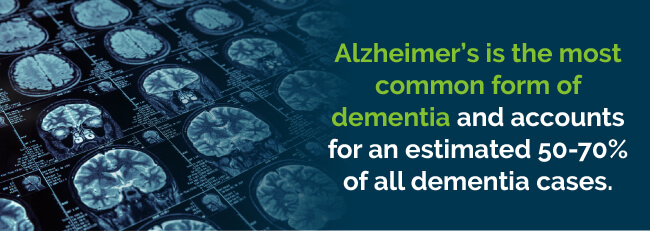More people today are turning to alternative treatments and healing methods for chronic and degenerative diseases. There are several reasons for this shift toward natural remedies. Many patients haven’t gotten the results they’ve wanted from conventional medicine or have experienced harsh side effects. Others are simply looking to see what options are available that they can use in conjunction with their prescription treatments.
Whatever the reason, there’s no question that natural remedies are gaining more popularity among mainstream consumers, especially those affected by chronic disease.
Medical cannabis is one of these natural treatments that patients are turning to for symptom relief and disease treatment. Medical cannabis has proven to be beneficial for many chronic, degenerative conditions, including Alzheimer’s disease. This is encouraging news for patients and their families who have long suffered from the tragic and devastating effects of this cognitive disease.
The healthy brain is made up of millions of interconnecting nerve cells called neurons. Neurons constantly communicate with each other by sending signals through tentacle-like connections called axons and dendrites. The brain of a patient with Alzheimer’s Disease is much different. The orderly, organized arrangement of nerve cells found in a healthy brain become entangled, full of senile plaques and neurofibrillary tangles. The plaques and tangles interfere with the normal activity between neurons in the area of the brain responsible for intellectual thought. Alzheimer’s Disease affects people in different ways. The disease is slowly progressive from onset. Memory loss, confusion, disorientation and poor judgment are a few of the symptoms of Alzheimer’s Disease. Learn more below about how medical marijuana can help treat Alzheimer’s Disease.
Alzheimer’s Disease is a progressive neurological disease of the brain that leads to the irreversible loss of neurons. As a degenerative brain disease, Alzheimer’s slowly destroys memory and thinking skills, and eventually even the ability to carry out the simplest tasks.
It’s also the most common cause of dementia among older people. Dementia is a group of brain disorders characterized by impaired intellectual, social and cognitive abilities. Alzheimer’s is the most common form of dementia and accounts for an estimated 50-70% of all dementia cases.

Alzheimer’s disease affects an estimated 5.4 million Americans. By 2010, Alzheimer’s had become the sixth leading cause of death in America. It is now the fifth leading cause of death in people 65 years and older.
Alzheimer’s disease typically begins with mild or subtle symptoms that worsen over time. Generally, symptoms begin after the age of 60. It’s almost exclusively a disease that affects older people. Based on recent research, many experts believe the changes in the brain that lead to Alzheimer’s actually start more than 20 years before the initial symptoms start.
There is no cure for Alzheimer’s disease and there is no proven treatment to slow its progression. However, doctors commonly prescribe several medicines that may help improve the mental function of people with Alzheimer’s disease, such as donepezil and tacrine.
New research shows that medical cannabis for Alzheimer’s disease may prevent the formation of deposits in the brain associated with the degenerative disease. They have also found that marijuana is one of the most effective medications for Alzheimer’s disease.
Dr. Alois Alzheimer discovered Alzheimer’s disease in 1906. He first noted and reported specific neurodegenerative symptoms in his patient, Auguste D. She was exhibiting psychological changes such as paranoia, intellectual decline and memory loss. During her autopsy, Dr. Alzheimer noticed that the nerve cells in her brain had shrunk. However, without advanced microscopes, doctors wouldn’t be able to examine this condition further.
As biomedical technology advanced, doctors were able to better study these types of neurological abnormalities. Electron microscopes, invented in 1931, allowed doctors to magnify brain cells and see the damage in greater detail. By the late 1960’s researchers had established cognitive measurement scales, which helped determine how badly neurodegenerative symptoms had advanced.
As researchers continued to gather more information on Alzheimer’s symptoms, more and more national and international funding was invested into disease research. In 1974, the National Institute on Aging (NIA) was established to advance and support Alzheimer’s research. Today, there is an international effort underway to find a cure for Alzheimer’s disease by 2025.
Alzheimer’s symptoms are caused by shrinking parts of the brain that lead to neurological structural changes. The exact reason why this shrinking begins is still unknown. Researchers feel that rather than one major cause, there are instead several contributing genetic, environmental and lifestyle factors. This is especially likely given the prevalence of the disease. Researchers have identified specific risk factors that make a person more likely to develop Alzheimer’s disease.
Here are some of the possible contributing risk factors that may lead to Alzheimer’s disease in certain people:

Though it’s not known to be possible to reverse Alzheimer’s disease progress, adopting healthy lifestyle practices including diet and herbal remedies may help to slow the disease progression and prevent the risk of developing it.
Three known brain abnormalities can form in people with Alzheimer’s disease. Doctors can identify which of the brain abnormalities are present in a patient by examining brain tissue under the microscope. The three brain abnormalities that cause Alzheimer’s disease symptoms include:
1. Plaques: Plaques are clumps of beta-amyloid, a sticky protein that builds up between the brain’s nerve cells. These plaques prevent the synthesis of important neurotransmitters responsible for learning and memory function.
As these plaques accumulate, the brain becomes further impaired in learning and memory abilities.
2. Tangles: Brain cells require a transport system to acquire essential nutrients and minerals. These are transported through long extensions supported by a protein called tau. Unhealthy threads of tau protein in Alzheimer’s patients twist themselves and form tangles. This tangled network prevents cells from gaining proper nourishment, which causes them to die off.
3. Loss of Nerve Cell Connection: As tangles and plaques accumulate in the brain, it prevents the connection between nerve cells. Without a connection to one another, the cells die off. As more and more cells die off, it causes atrophy, which is shrinkage in brain tissue.
As a neurological disease, Alzheimer’s affects brain function in several ways. Alzheimer’s disease symptoms affect the following areas of cognitive function:
While there is no known cure for Alzheimer’s disease, there are a few conventional medications and treatments aimed at slowing disease progression. The two FDA-approved classes of drugs for Alzheimer’s disease are:
1. Cholinesterase Inhibitors: These drug types boost the production of a neurotransmitter called acetylcholine. Acetylcholine plays a role in learning and encoding new memories. Patients with Alzheimer’s disease have depleted levels of acetylcholine. Cholinesterase inhibitors can control symptoms such as agitation and depression.
Prescription cholinesterase inhibitors for Alzheimer’s disease include:
Common side effects of cholinesterase inhibitors include diarrhea, nausea and sleep and appetite loss.
2. N-methyl-D-aspartate (NMDA) Receptor Antagonists:NMDA receptor antagonists treat moderate to severe cases of Alzheimer’s disease. This drug aims to regulate levels of glutamate, an important neurotransmitter for learning and memory. Memantine is a brand of NMDA receptor antagonist drug prescribed to Alzheimer’s patients. Side effects of Memantine include constipation, headaches and dizziness.
As the population ages, there will continue to be an increased demand for Alzheimer’s treatments that can help manage symptoms and slow disease progression. Many people are looking for safe alternatives to conventional Alzheimer’s disease medications. Research continues to show promising results with medical marijuana for Alzheimer’s disease as one of the alternative treatments.
The cannabis plant contains over 60 different compounds, many of which are proving to have important health properties for disease treatment. Ongoing research investment is continuing to uncover the exact link between cannabis and Alzheimer’s and how it may work to treat neurodegenerative diseases. So far, studies have shown specific abilities of certain cannabis compounds to target brain abnormalities in Alzheimer’s disease patients.
For example, in an article titled “A Molecular Link Between the Active Component of Marijuana and Alzheimer’s Disease Pathology,” published in Molecular Pharmaceutics, Lisa M. Eubanks, PhD (Staff Scientist at the Scripps Research Institute and the Skaggs Institute for Chemical Biology) reported that THC is a considerably more effective inhibitor than the approved drugs for Alzheimer’s disease treatment, donepezil and tacrine.
Furthermore, she stated that “THC and its analogues may provide an improved therapeutic for Alzheimer’s disease [by] simultaneously treating both the symptoms and progression of Alzheimer’s disease.”
Another researcher, Maria L. de Ceballos, PhD, Group Leader in the Department of Neural Plasticity at the Cajal Institute in Spain, found in a recent marijuana study that the cannabinoid receptors found in marijuana are important in the pathology of Alzheimer’s disease and that cannabinoids succeed in preventing the neurodegenerative process occurring in the disease.
Unfortunately, research into the benefits of medical cannabis for Alzheimer’s disease and myriad other health issues has been largely stymied in the United States due to federal government roadblocks fueled by pharmaceutical company “intervention.” However, the research that has been conducted in the U.S. and abroad shows that there are several specific ways that marijuana may be able to help those suffering from Alzheimer’s.
Here are five ways cannabis for Alzheimer’s disease helps treat cognitive decline:
1. THC and Neural Plaques: Tetrahydrocannabinol (THC) is the psychoactive compound found in certain cannabis strains. Multiple studies have looked at the effects of THC on neural plaques. THC has been shown to slow the formation of damaging plaque in the brain.

It appears that small doses of THC slow the growth of beta-amyloid, the protein responsible for creating neural plaques. In fact, one study showed that THC content in medical cannabis had a greater ability to stimulate neural plaque removal than Alzheimer’s medications, Aricept and Cognex.
2. CBD and Cellular Health: Cannabis also contains another plant compound called cannabidiol (CBD). Unlike THC, which produces psychoactive and mind-altering effects, CBD offers other health benefits that can help treat Alzheimer’s disease. CBD has natural anti-inflammatory, antioxidant, analgesic and sedative properties. Neurological studies on CBD have shown that it can help slow the process of cell death, known as apoptosis. Used in combination with THC, it has shown promise in reducing oxidative injury, inflammatory events and other mechanisms that help contribute to degeneration of the brain. This means CBD can help Alzheimer’s patients by preventing healthy brain cells from dying off.
3. Cannabis and Inflammation: It is believed that a major contributing factor to Alzheimer’s development is inflammation around plaque that builds up in the brain. Cannabinoids have shown promise in reducing inflammation and slowing cognitive degeneration as a result.
Initial animal testing has shown that cannabis can help lower inflammation around neural plaques. Specifically, cannabis activates an anti-inflammatory effect, which helps slow cognitive decline. Though it hasn’t yet been proven in humans, researchers feel that there is a possible connection between cannabis and reducing neurological inflammation in humans. Continued research can help to confirm this and provide further support for medical marijuana and Alzheimer’s disease treatment.
4. Cannabis and Cellular Growth: Studies have also examined how cannabinoids show promise in helping to stimulate the growth of tissue in the portion of the brain that controls memory, known as the hippocampus. For Alzheimer’s patients, this means that cannabis may help improve memory function by stimulating greater rates of neuron growth.
5. Cannabis and Alzheimer’s Symptoms: Alzheimer’s patients typically suffer from a wide range of symptoms. Cannabis has also shown an ability to help improve quality of life in Alzheimer’s patients by reducing and managing many of these symptoms. Marijuana is a known appetite stimulant, and provides a relaxed feeling. These and other properties can help greatly improve the quality of life of people suffering from this terrible disease. Here’s how cannabis can help treat Alzheimer’s disease symptoms:
While the research points to cannabis potentially helping slow disease progress, for many patients the improved quality of life is reason enough to choose medical cannabis as a treatment for Alzheimer’s disease.
While there isn’t yet sufficient evidence to recommend standardized dosages of medical marijuana for Alzheimer’s disease, there are certain strains that can help treat specific aspects of the disease. Here are some considerations when choosing strains of medical cannabis for Alzheimer’s disease:
Choosing a cannabis strain is only part of the decision when finding your ideal medical marijuana for Alzheimer’s disease treatment. You’ll also need to decide on how to use the treatment. Here are two ways to use medical cannabis for Alzheimer’s disease:

Using edible medical marijuana for Alzheimer’s disease can be a bit tricky at first, however. Because someone can’t feel the effects right away, he or she may be more prone to eating too much. The best way to use edible cannabis is for the patient to eat a small amount first on an empty stomach, wait about an hour, and then decide if he or she needs more. An expert at a local medical marijuana dispensary can provide guidance to take much of the guesswork out of the edible approach.
Medical cannabis is generally considered very safe to use. However, as with all medicinal treatments, it’s important to consider the potential side effects associated with medical marijuana for Alzheimer’s disease. Here are some of the side effects and precautions to be aware of:
While researchers are continuing to test the efficacy of medical cannabis in clinical trials, the ongoing research is showing promising results for Alzheimer’s disease patients.
Medical Marijuana is an affordable, natural alternative that has helped thousands of Alzheimer’s disease patients. If you or someone you love is suffering from Alzheimer’s disease and would like to find out if medical marijuana is the right treatment for you, book an appointment with a local, qualified physician through MarijuanaDoctors.com today. And sign up for the MarijuanaDoctors.com newsletter for up-to-date information on medical cannabis. Let us help improve your quality of life!
Find A Doctor Find A Dispensary
For more information about how cannabis can be used to treat Alzheimer’s Disease, check out our resources: